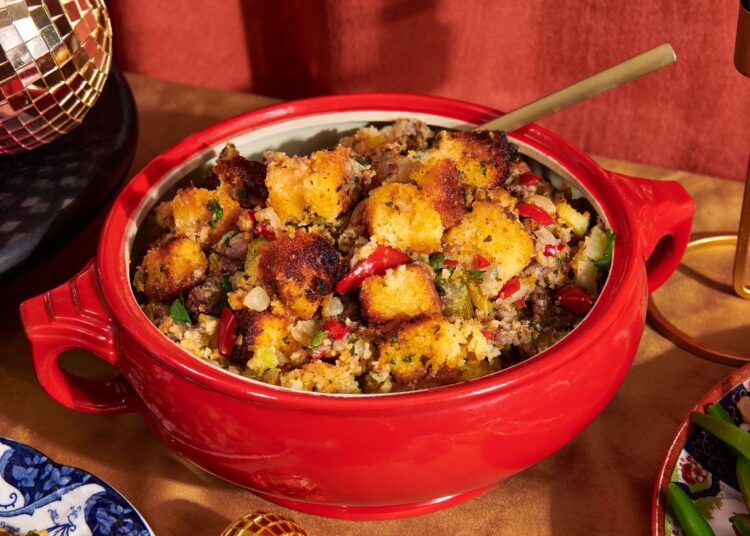Dina Ávila/Eater
Bread cubes are the key to a great stuffing. Yours deserves an upgrade.
Every year, my sister and I have a stuffing-off. Not that we’re all that competitive (we are), but she insists on having her signature mushroom and sage stuffing, and I insist on making the best stuffing. My recipe is just an old Gourmet magazine version of sausage cornbread stuffing with a bunch of fennel, but what makes it exceptional is my own riff on what is so often overlooked as filler when it comes to stuffing (or, depending on where you’re from, dressing): the bread cubes.
Let me begin by saying that this is not a hack. This is the opposite of a hack. A hack should save you time and/or money, and this does neither. Think of this more as an upgrade — one that I spent years perfecting, looks as good as it tastes, and has cast me squarely as the winner of the family stuffing battle for the last three years running.
It all began when, out of sheer laziness, I purchased some store-bought stuffing cornbread cubes from Whole Foods. Yes, Whole Foods. These suckers were expensive and huge — like a gallon bag full of bready Rubik’s Cubes — but they had just the right balance of sweet to savory and were hard as a rock, which made them the ideal sponges for all the juicy fennel-sausage business lurking within the dish. I used these for a couple of years, but they were honestly too big — I had to cut each cube into quarters in order to make them layer neatly in a casserole — and then one year, I just couldn’t find them anymore. I searched the bakery and deli sections, I asked some bewildered staff, but nothing. Vanished. I was devastated but determined. And so began my half-decade search for the ideal cornbread cube.
I started by making my own cornbread from scratch, which definitely sounds fancy but was actually just a lot more time consuming, and the resulting bread was always way too moist. I could never quite get it to dry out enough to cut neatly into cubes, and no amount of time in the oven took that home-baked chew away. Stuffing cubes need to be crunchy, not chewy. Then I tried just buying the classic sourdough stuffing cubes, but it changed the entire flavor profile of the dish and took it from a showstopper side to just… stuffing.
Dina Ávila/Eater
Finally, a few years ago, I had returned to Whole Foods in desperate hopes of finding my beloved cubes when I stumbled across some full loaves of their signature cornbread. I bought a few (for like $6 each; y’all, this is truly ridiculous), sliced them into cubes — a bit smaller than the original version, but still whopping enough to make an impact — stuck them in a low oven (around 200 degrees) for an hour or so, and eureka! I had it nailed. That year’s stuffing was the best ever, and it continues to deliver again and again.
Why? It’s all about the size. Larger, custom-cut cubes of bread turn what can be a pile of mush into more of a savory bread pudding. The large points that jut up from the surface get bronzed, caramelized, and crispy in the oven, while the cubes below are able to retain some semblance of structure, even after soaking up all the flavors like a beautiful, golden sponge. It’s a textural masterpiece. The important takeaway here is that when it comes to stuffing cubes, bigger is better, and the symmetrical shapes make the dish look geometric, intentional, restauranty.
Why are the store-bought loaves the key? I’m not quite sure. My hunch is that they’re just dense enough, un-fresh enough, and mass-produced enough to dry out easily, and the store’s recipe strikes some unicorn balance of flavor that compliments the fennel without making the dish overwhelmingly sweet. I’m fully convinced that, with another few years of tweaking, I could nail a home-baked loaf that would achieve the same results. But for now, I’m sticking with my Whole Foods version, because if it ain’t broke (and it saves two days of baking and drying time), don’t fix it. Though, after spending nearly $20 on a bunch of old bread year after year, the broke one might be me.
Dina Ávila is a photographer in Portland, Oregon.
Photo assistant: Eric Fortier














